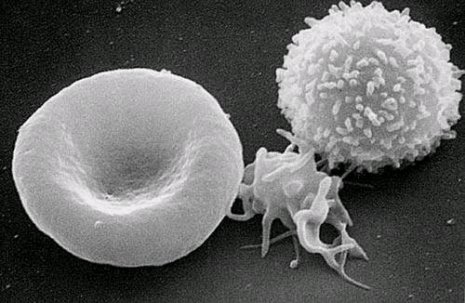
Image in the pubic domain
A recent issue of Science has a very interesting article on blood platelets.1 As nearly any textbook that discusses human anatomy and physiology will tell you, there are three main types of blood cells: red blood cells, white blood cells, and platelets. As indicated by the scanning electron microscope image above, platelets are the smallest of the three.
In addition, almost any textbook that discusses human anatomy and physiology will tell you that each blood cell is principally involved in one area of your body’s maintenance. Red blood cells are responsible for carrying oxygen to the tissues, although to a certain extent, they also pick up carbon dioxide waste from the tissues. White blood cells are responsible for cleaning the tissues of debris and fighting off invaders. Blood platelets are involved in clotting the blood so that we don’t bleed to death from a small cut.
Interestingly enough, this article indicates that blood platelets do a lot more than what most textbooks tell you!
According to the article, platelets are major players in the body’s immune system – something that was thought to be mainly the purview of the white blood cells. According to studies in mice, platelets have Toll-like receptors that recognize molecular features of foreign invaders. When these receptors detect an invader, the platelets help to produce inflammation, a crucial part of the immune response. They even latch onto invaders and deliver them to white blood cells so that they can be destroyed. In fact, at least one study indicates that a platelet can attach to a red blood cell that is infected with malaria and kill the parasite that is inside! Indeed, one of the researchers quoted in this article speculates that platelets are some of the most important pathogen detectors in the body.
Now you might wonder why this is surprising. Well, as I already noted, blood platelets are small. In fact, some textbooks claim they aren’t really cells. Instead, they are just fragments of larger cells.2 Also, they do not have a nucleus, which means they have no nuclear DNA. Well, in order to do things like start an inflammatory response, kill parasites, etc., a cell must be able to manufacture proteins. What makes a cell able to manufacture proteins? Generally, it is the cell’s nuclear DNA. The DNA provides a “recipe,” telling the cell how to make certain proteins, and the cell reads that “recipe” in order to manufacture what it needs. It was assumed that blood platelets cannot make proteins, because they have no nuclear DNA. Nevertheless, researchers have actually demonstrated that platelets make specific proteins in response to specific stimuli. Right now, it is hard to understand exactly how they do that, but experiments indicate that they do.
Another surprise in this article is that some researchers are convinced that blood platelets can reproduce. Most platelets in the body do not come from other platelets. Instead, they come from cells called megakaryocytes. These cells produce tendrils that bore into a blood vessel, and the flow of the blood within the blood vessel tears the tendrils apart. The remnants of those tendrils become blood platelets. This is why some texts characterize them as fragments of cells.
Once again, since blood platelets have no nuclear DNA, it is unclear how they can reproduce. Nevertheless, there have been some experiments that seem to demonstrate that they can. Thus, even though most of the platelets in your body do not come from platelet reproduction, it is possible that some do.
These little cells are providing scientists with big surprises. Stay tuned to see how our understanding of these wonderful cells improves!
REFERENCES
1. Mitch Leslie, “Beyond Clotting: The Power of Platelets,” Science 328:562-564, 2010.
Return to Text
2. Elaine N. Marieb, Anatomy and Physiology, (Benjamin Cummings, 1991), p. 557.
Return to Text
